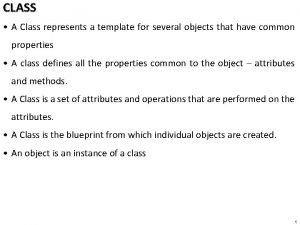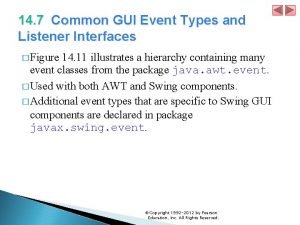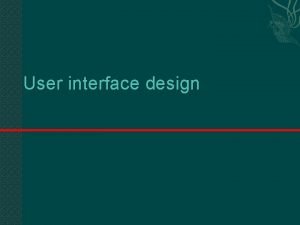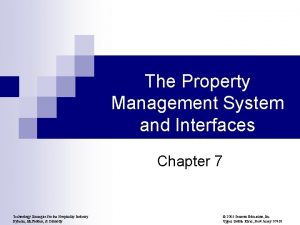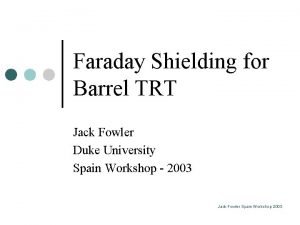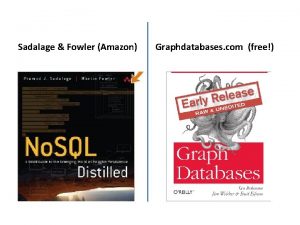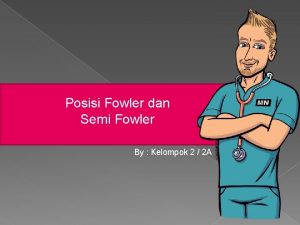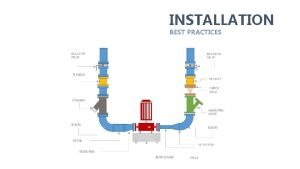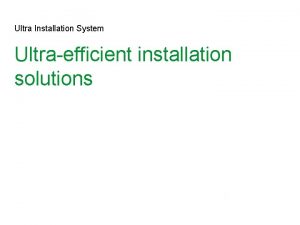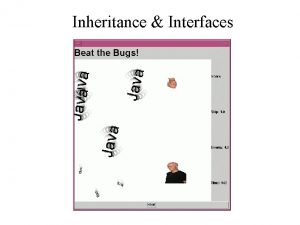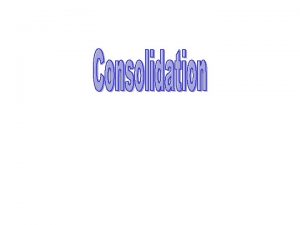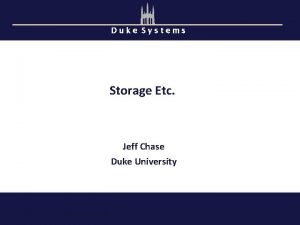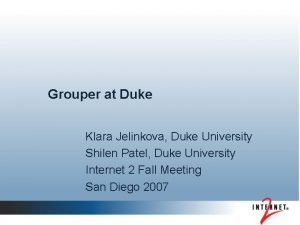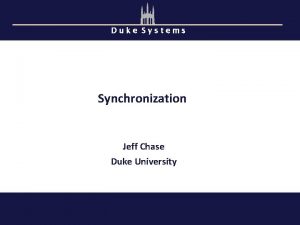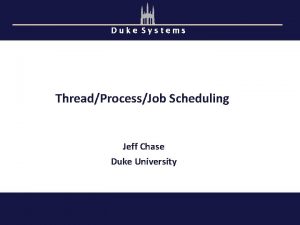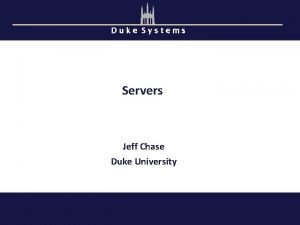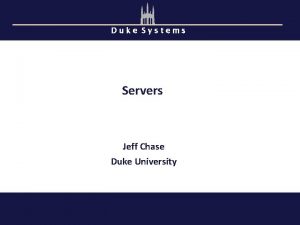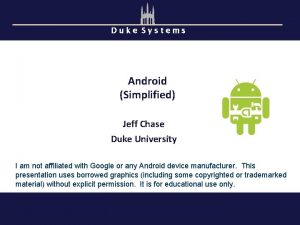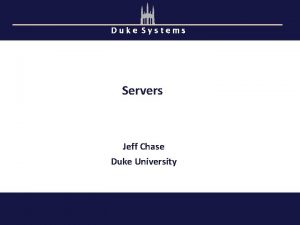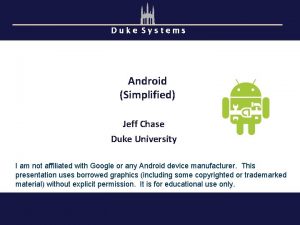Installation Infrastructure Interfaces Underground Jack Fowler Duke University
























- Slides: 24

Installation Infrastructure Interfaces Underground Jack Fowler – Duke University Joe Howell - FNAL

Outline • • • Material handling Hatches and access Installation space Power requirements Electronics and computing Ventilation and lighting TPC support Detector grounding Cryostat heaters 2

Material movement • Ability to lower ~ 7 L x 1. 2 W x 2. 5 H m items down the shaft. – Loading and unloading both at the surface and 4850’. – Ability to navigate this item from the shaft exit (which one will be used? ) through the drifts to the installation area above the cryostat. – Mechanical towing device to move items. (fork lift, automatic towing device or cart, rails, etc. ) Path needs to be relatively smooth to limit shock to items inside containers. • Space to store, at a minimum, one of these items (7 L x 2 W x 2. 5 H m) in a room or drift along the way from the shaft to the installation area. We are assuming that the CPA and field cage material can be broken down and packaged as to fit inside the cage. The quantity and size of these containers may change the storage needs underground. • Need to understand if the Ross, Yates or both will be used for material transport for the detectors. This may affect what is planned for the drifts from Yates. 3

Hatches and access • The current plan for installation requires a hatch inline with every row of APA. This eliminates the space needed for a distribution rail at the end of the cryostat. The current estimate for the hatch is 4. 8 m L (parallel to the APA row) and 2. 5 m W. • We currently do not require a full height scaffold tower at each of these hatches for installation. However, we do require a method to move personnel to the floor of the cryostat for installation work. • We do require access to the top of each APA and CPA in its final position to attach cables and for field cage installation. We assume the lower APAs and CPAs can be access from the floor. • For pre-installation, we will need access to route the cable and cable trays down the side walls of the cryostat for the lower APAs. • Need to understand how the hatch interfaces with the truss work on top of the cryostat. • Secondary egress from inside the cryostat needs to be considered in determining the number of personnel hatches required. 4

Installation space • A class 100 k clean space is needed above the installation hatches for the TPC elements. This also requires that the inside of the cryostat has a similar cleanliness rating. • With the current underground layout, we estimate that this clean space will be approximately 17 L x 17 W x 7 H m. Need to understand how this affects the cryostat installation laydown space. • We will need a material entrance ~ 2 W x 4 H m. This allows for ~ half of the entrance drift to be used to access the top of the cryostats. We could size the material entrance to that of the cage dimensions. • Personnel access to the clean space will be through a gowning room ~ 3 x 5 m. • Working with portable gantry cranes allows the layout to be more flexible and decouples the requirements for overhead conveyances from CF. It also allows us to easily enclose the clean space overhead. 5

Preliminary installation space layout Outline of clean space Material Entrance Portable Gantry Crane Gowning room Installation hatch Work/Test space Material racks This layout is for 2 rows of APAs, need to update for 3 rows of APAs. 6

Ventilation and lighting • Inside the clean space and cryostat, the ventilation needs to be filtered to achieve a class 100 k clean room. This will require HEPA filters for both spaces. • Inside the clean space and cryostat, all lighting will need UV filters to prevent damage to the photon detector assemblies (this assumes the current design). This may also affect the lighting around the clean space unless the clean space “barrier” is a UV filter as well. • The clean space needs to be designed so that it does not affect the overall ventilation path of the underground space. It cannot completely block the airflow through the space above the cryostat. 7

Current FD power requirements Preliminary List of Detector 10 kt Cavern Equipment Equip. Name-BLDG Lighting-Cavern Lighting-Drifts HVAC-Chiller HVAC-Circulating Pumps HVAC-Fan Coil Units HVAC-Air handler supply fan HVAC-Air handler exhaust fan Sump Pumps Vent Fans Welding Outlets Monorail crane-10 ton-hoist(15)+trolly(1) Quantity Power 1 35 1 10 2 149. 2 4 22. 38 30 1. 492 1 14. 92 6 3. 73 6 1. 492 4 41. 57 1 11. 936 Unit k. VA k. W k. VA Power (Tot) Generator Backup 35 yes 10 yes 298. 4 89. 52 44. 76 14. 92 22. 38 8. 952 166. 28 no 11. 94 yes Power Source Notes 200 HP 30 HP 20 HP 5 HP 2 HP (480 V/50 A). . Millers David Matinary (work cell hoist) 16 HP*746 Fire VESDA HSSD system in cryostat 1 1. 5 k. VA 1. 5 yes yes Paul-SURF sniffer Halon Nitrogen Booster Compressors Liquid Argon Pumps Heater Cables Purification Skid (Blowers) Purification Skid (Cooling) Purification Skid (Heating) System Controls 4 4 2 2 1 111. 9 5. 2 12. 6 28 21. 1 63. 6 3. 0 k. W k. VA 447. 6 20. 8 25. 2 46 21 64 3 no no no yes 150 HP each 480 V SLAC RCE System Test Area Temporary lighting in cryostat Temporary ventilation in cryostat: blower Temporary ventilation in cryostat: compressor General air monitoring in cryostat Hoist near hatch-3 ton-hoist(2 HP)+trolly(. 5 HP) 4 1 1. 8 1. 3 0. 746 3. 9 k. VA k. W no yes yes 3 racks + 1 table + 1 bench 15 A service 1 W/ft^2 3 -ton, 1 HP 1 1. 865 k. VA 7. 2 1. 3 0. 75 3. 9 TBD 1. 87 yes (hoist in cryostat) 2. 5 HP*746 Power for potential battery charging station/powered carts HEPA filter blower units 1 10 6 0. 336 k. W 6 3. 36 no yes similar to uboone clean room Total Power (k. VA) 1372. 77 L. Bagby - FNAL 8

Electronics and Computing • Current feed thru estimates. – Services feedthru – 1 per CPA plane for HV (~150 mm CF), 1 per 2 APAs for PD and CE (~250 mm CF) – Calibration – what is needed and where? – Instrumentation – purity monitors, flow and temperature sensors, light pulsers (all will need feed thru flanges). • Racks – safety, cooling, smoke detection, rack protection and their proximity to the detector and feed thrus (some required on top of detector which adds load to top cap design). • Clean power with separate grounding for detector. • Normal power. • UPS power – need to establish requirements. • Computing racks. • Control room space for DAQ and detector monitoring underground? • Cable management. 9

Current Far Detector Rack Equipment Preliminary List of Detector Electronics Rack types and contents-Per Detector # of racks Location Rack Name FD Si. PM system Rack Components Space (U) Quantity HV Power Supply Shaper Power Supply backplane Splitter Si. PM FE amplifier Computer Power (VA) Power Tot (VA) Notes TBD 2 ps/port Caen 5740 ch 32, 4 APAs TBD 16 channels TBD Cold Electronics Wiener MPOD 80 8. 1 648 2560 ch/apa, 10 m. W/ch. (200 W) (4 MB/APA) (20 APA) 40 W/APA=65 W*20=1300 1. 5 V/. 6 A, 2. 1 V/1 A, 2. 8 V/1 A, 3. 6 V/. 5 A, 5 V/. 1 A Drift HV Power Supply 4 230 920 -115 k. V/1 m. A, Heinzinger PNChp 150000 -1 neg/M 230 V/1 A (1 -ph), 400 V/1 A (3 -ph) other avail. TPC Wire Bias Wiener MPOD 20 7 140 Vg: -1 k. V, Vu: -1 k. V, Vx: +1. 5 k. V all 2 m. A (20 APA) Field Cage Bias Wiener MPOD 1 2 2 1710 -1 k. V/2 m. A Computers Rack Protection 15 Smoke Sensor Rack Protection Mon PDU (Power Dist. Units) Slow Controls Intl'k Switch Hot Spares Rack Total (k. VA) 15 15 15 3 1 2 assume 15 racks per detector 120 V/<1 A Power requirement based on service. 2400 3 43200 120 V/20 A service 43. 20 L. Bagby - FNAL CERN Neutrino Platform Meeting 10

TPC support • For numerous reasons, it has been determined that the loads of the TPC should be supported independent from the cryostat structure. This will require a separate support structure that attaches to either the rock walls or the cavern floor outside the cryostat. • This will require – Anchor points along the length of the cryostat to attach some structure over the cryostat. – Feed thrus in the cryostat roof that allow the structural loads of the TPC to pass through the membrane, insulation and cryostat structure. – The current TPC design requires a load point for each of the 5 rows every 5 m in length. These load points will need to accommodate thermal contraction, in both directions (length and width), of the TPC elements. For SS this is ~ 2. 8 mm / m for LAr temperature. 11

Detector grounds • There were plans to have a ufer ground that attached to the metal rebar in the concrete and rock bolts surrounding the cryostat. How will this be affected by the freestanding cryostat? Are there any requirements for installing any ground structure on the outside of the cryostat structure? • How will the top plate grounding scheme be implemented with the freestanding cryostat and separate TPC support? • See the next 4 slides for more details and requirements from D. Montanari and T. Shaw on the grounding for the single phase test at CERN and SURF. 12

Cryostat Grounding/Isolation Requirements Parameter Value Isolation 1) 2) Grounding 1) 2) 3) Top plate grounding 1) The cryostat membrane and any supporting structure shall be isolated from any building metal or building rebar with a DC impedance greater than 300 k. Ohm. All conductive piping penetrations through the cryostat shall have dielectric breaks prior to entering the cryostat and the top plate. The cryostat, or “detector” ground, shall be separated from the “building” ground. A safety ground network consisting of saturated inductors shall be used between detector ground and building ground. Parameters TBD. The top grounding plate shall be electrically connected to the cryostat membrane by means of copper braid connections. a) Each connection shall be at least 1. 6 mm thick and 63. 5 mm wide. b) The length of each connection is required to be as short as possible. c) The distance between one connection and the next one shall be no more than 1. 25 m. d) The layout can follow the profile of several pieces of insulation, but it shall be continuous. e) The DC impedance of the membrane to the top plate shall be less than 1 ohm. Note: The layout of the top plate grounding is outlined in the next slide. These are the requirements from the former LBNE. They are being further analyzed and may change. 13

Top plate grounding layout Note: These are the requirements from the former LBNE. They are being further analyzed and may change. 14

Conceptual grounding diagram 15

Conceptual structural grounding diagram 16

Cryostat heaters • Is there still a requirement for the heaters around the cryostat with a freestanding design? It is probably still needed under the cryostat in the concrete floor. • Are there concerns now with condensate forming on the structure and causing corrosion? 17

ES&H Considerations • Access & Egress Procedures – Personnel accountability (including sign-in and sign-out for cryostat entry) – Two person rule – Communication • Ventilation and lighting (temporary equipment for work in the cyrostat) • Emergency response procedures – Rescue equipment • Non-permitted confined space (for normal TPC installation work) – Air quality monitoring • Fire detection – VESDA smoke detection • Crane operation procedures • Hazard analysis for the installation tasks Fermilab Environment, Safety and Health Manual (FESHM) 5063 Confined space – A space that: 1. Is large enough and so configured that an employee can bodily enter and perform assigned work; and 2. Has limited or restricted means for entry or exit; and 3. Is not designed for continuous employee occupancy Non-Permit Confined Space – A confined space that does not contain or, with respect to atmospheric hazards, have the potential to contain any hazard capable of causing death or serious physical harm. 18

More ES&H Considerations • We plan on high-sensitivity smoke-detection (HSSD) system in the cryostat, from CDR “A ventilation system and air-monitoring sensors with alarms that will assure adequate air quality for the personnel working inside the cryostat. The system will also include a HSSD system that is interlocked to the power for all devices inside the cryostat. ” • From discussions long ago with Mike Andrews, we do not need a fire suppression system inside the cryostat, but there will need to be tight controls on the combustible material used. 19

Back ups 20

Installation concept to reduce the head space Tooling and the hatch size will be designed to reduce the head space and crane height above the cryostat. The APAs will be located over the hatch and rotated to vertical into the hatch opening. 21

Upper APA being rotated to vertical above. Access during installation Support Rail Work Platform Lower APA supported from the platform A suspended platform will be installed at each of the hatches. From the platform, the first APA will be supported while the second is rotated overhead. Technicians can work from this platform to join the two APAs and to attach the column to the support rail. 22

Layout of 35 t racks Trig_Scint TPC_PD Purity Monitor Calibration DAQ_1 DAQ_2 RPS RPS RPS 1 Empty Empty 2 Cable Dressing Ethernet Switch-2 NIM Bin Camera System Nova Timing Master 3 CCU 4 Wire Manager 4 ANL Calibration Module Ethernet Switch-1 5 Empty Wire Manager 6 Cable Dressing Empty 7 PC-1 8 PC-2 10 CCU 3 Fan 8 x SSP Empty PM Multiplexer Penn Trig board Empty 9 11 Empty PC-3 Empty PC IU Calibration System Empty PC-4 Empty PC-5 Nova Timing Slave NIM Bin 12 Surge. X Empty Nova Timing Master Empty Wiener MPOD-Wire/FC 13 14 15 16 17 18 PC-6 19 Empty 20 Nova Timing Slave Empty NIM Bin Empty 21 PC-7 22 Fan 23 Empty PC-8 24 PC-9 25 26 Wiener MPOD-LV 27 Fan Empty 28 ATCA Shelves 29 Empty 30 CCU 2 31 Fan/Plenum 32 Cable Dressing Empty CCU 1 33 Empty Nova Timing Master 34 35 Crate Power Supply 36 Cable Dressing Empty AC Switch Box Empty 37 Impedance Monitor 38 Empty 39 AC Switch Box Empty AC Switch Box 40 41 42 Racks currently on top of Cryostat L. Bagby - FNAL CERN Neutrino Platform Meeting 23

Portable gantry crane Wallace 3 Ton and 5 Ton Tri-Adjustable Steel Portable Cranes http: //www. wallacecranes. com/triste 3. htm C Max C Min D E Max E Min F G H 23' 7" 15' 2" 12' 9" 13' 11" 9' 5" 14" 8" 12" Ship Wt Model 2451 3 T 2420 SAC 24
 Jack fowler musician
Jack fowler musician Etf trading essentials
Etf trading essentials Main characters in jack and the beanstalk
Main characters in jack and the beanstalk Duke university blockchain course
Duke university blockchain course Duke cpt application
Duke cpt application Duke university
Duke university Duke university
Duke university Expressive interfaces
Expressive interfaces![[web user interface] [web user interface]](data:image/svg+xml,%3Csvg%20xmlns=%22http://www.w3.org/2000/svg%22%20viewBox=%220%200%20200%20200%22%3E%3C/svg%3E) [web user interface]
[web user interface] Uml interfaces are used to:
Uml interfaces are used to: Office interface vs industrial interface
Office interface vs industrial interface What is difference between abstract class and interface
What is difference between abstract class and interface Difference between abstract classes and interfaces
Difference between abstract classes and interfaces Expressive interfaces
Expressive interfaces Dialogues
Dialogues Blueprint interfaces
Blueprint interfaces Common gui event types and listener interfaces in java
Common gui event types and listener interfaces in java Which is not an objective of designing interfaces?
Which is not an objective of designing interfaces? Property management system interface
Property management system interface Colloid examples
Colloid examples Difference between abstract class and interface
Difference between abstract class and interface Ims platform
Ims platform Process flow of web interface design in hci
Process flow of web interface design in hci Bts ms sp
Bts ms sp Expressive interfaces
Expressive interfaces




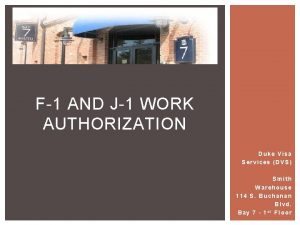
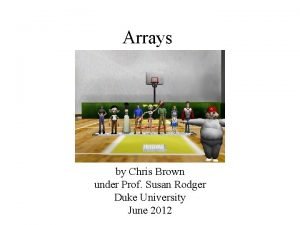


![[web user interface] [web user interface]](https://slidetodoc.com/wp-content/uploads/2020/12/3515569_e80293ca9d02734a3126f3e8d1d1c3b7-300x225.jpg)


